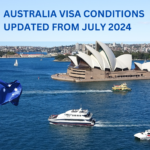
2024 Cap on International Students Canada
Canada has made modifications to its foreign student visa application procedure. Canada is renowned for its welcoming and diverse educational environment. We will examine the most recent announcements made by the Canadian government in this blog article, along with their consequences for both existing and potential international students Canada. For individuals who intend to continue their study in Canada, it is imperative that they comprehend all aspects of these developments. 1. The New Horizon: Overview of the International Students Canada Visa Cap Canada has taken a proactive step by introducing a cap on international student visa applications for the next two years. This measure aims to moderate new growth and ensure the sustainability of the influx of international students Canada. As of 2024, the cap is set at 360,000 authorized study permits, marking a 35% reduction from the previous year. 1.1 The Cost-of-Living Adjustment: Addressing Student Vulnerability Effective January 1, 2024, the cost-of-living requirement for study visa applicants was revised to better reflect the genuine cost of living in Canada. This adjustment seeks to minimize student vulnerability and exploitation, making the overall studying experience more accessible and secure. 2. Special Considerations: Who Is Affected and Who Is Not While the cap poses limitations, certain groups are exempted from its impact. Renewals of study permits will remain unaffected, providing continuity for those already pursuing their education in Canada. Moreover, individuals pursuing master’s and doctorate degrees, along with those in elementary and secondary education, are not subject to the cap, allowing them to proceed with their academic endeavors without hindrance. 2.1 In-Demand Talents and Permanent Residency: A Promising Pathway Despite the cap, Canada remains committed to providing clear routes to permanent residency for students with in-demand talents. The government is actively exploring innovative approaches to facilitate a smoother transition for international students Canada into the workforce, emphasizing fairness-driven, weighted population-based caps on specific provinces and territories. 3. Practicalities of the Cap: Application Procedures and Attestation Letters Commencing January 22, 2024, each study permit application submitted to the Immigration, Refugees, and Citizenship Canada (IRCC) must include an attestation letter from a province or territory. This letter is a crucial component for imposing the cap and ensuring a fair distribution of study permits. Provinces and territories have until March 31, 2024, to establish a streamlined process for providing attestation letters to students. 3.1 Cap Distribution: From IRCC to Provinces and Territories To implement the cap effectively International Students Canada, the IRCC will distribute a portion of the cap to each province and territory. The responsibility then falls on these regions to divide the allocated permits among approved educational institutions, adding an additional layer of transparency to the process. 4. Looking Ahead: Future Reevaluation and Collaboration The two-year temporary measure brings about uncertainty regarding the future of international student applications. However, the Canadian government assures a reevaluation of the number of new study permit applications in 2025. Meanwhile, collaboration with designated learning institutions, national education stakeholders, and provinces and territories will persist to create a sustainable future for international students. 4.1 Stakeholder Engagement: Building a Sustainable Future During this period, the Canadian government will actively engage with designated learning institutions, national education stakeholders, and provinces and territories. This collaborative effort aims to address challenges, gather insights, and collectively work towards creating an environment conducive to the success and well-being of international students Canada. In conclusion, the recent developments in the international student visa application process underscore the Canadian government’s commitment to balancing growth with sustainability. While the cap introduces challenges, exemptions and pathways to permanent residency demonstrate a nuanced approach. As prospective and current international students canada, staying informed and adapting to these changes will be key to a successful academic journey in Canada.






